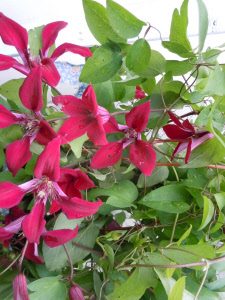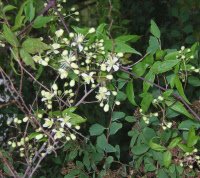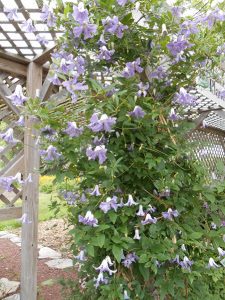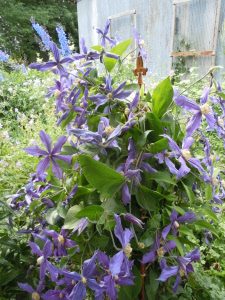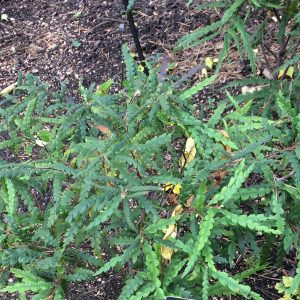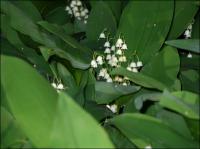Our Plants
Showing 145–152 of 587 results
-
Clematis texensis ‘Gravetye Beauty’ Z 5-9
Small crimson-red bells dangle from July to September
Small crimson-red bells dangle from July to September
Size: 8’ x 3’
Care: Sun in humusy, fertile, moist well-drained soil. Mulch around the base. Flowers on current year’s stems so cut back to 6-9” in late winter or early spring.The genus Clematis was named by Dioscordes, physician in Nero’s army, from “klema” meaning climbing plant. The species 1st collected by the “Father of Texas botany,” Ferdinand Lindheimer in 1830’s. Max Leichtin of the Baden Garden sent Clematis texensis to Kew Botanic Garden near London in 1880’s. French nurseryman Francisque Morel sent this selection to William Robinson who named it for his English nursery at Gravetye Manor in 1914.
-
Clematis virginiana Virgin’s bower, Devil’s darning needles Z 4-8
July-September star-like white blossoms
July-September star-like white blossoms cover this vine – good for clambering up small trees.
Size: 12-20’ x 4’
Care: Sun to shade moist well-drained soil. Flowers on new stems so cut back in late winter or early spring to 6-8” above the ground.
Native: Nova Scotia to Georgia and as far west as Kansas, Wisconsin nativeThe genus Clematis was named by Dioscordes, physician in Nero’s army, from “klema” meaning climbing plant. One of 1st No. American plants sent to Europe – grew in Tradescant the Elder’s South Lambeth nursery in 1634. Grown by Jefferson at Monticello in 1807. Described by Breck in his 1851 book The Flower Garden: “The flowers are white borne upon cymes, and make a handsome appearance.” Cherokee mixed this plant with milkweed to remedy backaches. A root extract cured stomach aches, nervous conditions and kidney ailments. For the Iroquois powdered root fixed venereal disease sores and an extract of the stem brought on strange dreams. Pressed specimen in Emily Dickinson’s herbarium.
-
Clematis viticella ‘Betty Corning’ Z 3-9
Pendulous lavender trumpets
Pendulous lavender trumpets with bodacious flares bloom profusely, blooming machine all summer into fall.
Size: 8-10’ x 8’
Care: sun to shade in moist well-drained soil. Prune back to 1’ above ground in early spring.
Awards: Elisabeth Carey Miller Botanic Garden Great Plant Pick; Cary Award Distinctive Plants for New England; and England’s Royal Horticultural Society Award of Garden Merit.Selection of a cross between Clematis crispa and C. viticella, made in 1932 by Betty Corning.
-
Clematis x durandii Z 5-9
Big blue flowers from June to September
Big, deep indigo saucers – all summer into fall. The best short Clematis.
Size: 3-6' x 3'
Care: Full sun in moist well-drained to well-drained soil Prune back to a few inches above the ground in April. Needs staking or let it sprawl.
Awards: Elisabeth Carey Miller Botanical Garden Great Plant Pick.Cross of C. integrifolia and C. x Jackmanii, of garden origin. Hybrid from Durand in Freres France in 1874. William Robinson, father of mixed perennial borders, called this “effective and free.” (1933)
-
Cleome serrulata Rocky Mountain Beeweed, Spiderflower, Stinkweed Reseeding annual
Blooming all summer dozens of rose to lilac-colored flowers bunch together at the top of the 3-4” tall stem seemingly one soft-ball sized flower. Thread-thin stamens protrude above the flowers, each flower bearing six stamens, 72, for example, if the cluster contains a mere dozen individual flowers earning it the nickname spider flower. Short leaves grow the length of plant stems, from bottom to top, bare of flowers. A trio of leaflets to each leaf, one as a leader with two sidekicks.
OUT OF STOCK – EMAIL FOR AVAILABILITY
Blooming all summer dozens of rose to lilac-colored flowers bunch together at the top of the 3-4” tall stem seemingly one soft-ball sized flower. Thread-thin stamens protrude above the flowers, each flower bearing six stamens, 72, for example, if the cluster contains a mere dozen individual flowers earning it the nickname spider flower. Short leaves grow the length of plant stems, from bottom to top, bare of flowers. A trio of leaflets to each leaf, one as a leader with two sidekicks.
Size: 4' x 9"
Care: sun in moist-well drained to dry soil, drought tolerant
Native: Minnesota west to the Pacific, south to Arizona and New Mexico and all in between.
Wildlife Value: So many flowers, each with nectar and a hoard of stamens each holding pollen in a soft-ball sized object makes this a mecca for pollinators of all sorts, numerous bee species, wasps and several butterflies. When it’s done flowering birds eat its seeds. Its skunk-like odor (Stinkweed) has one advantage – it keeps the deer away.An ancient, pre-historic plant, Natives including Lakota, Zuni, Tewa, Navajo, and Pueblo found many uses for this Cleome. Some ate shoots, leaves, seeds or flowers, cooked them, or ate them raw alone or together with other food. Tewa grew this with corn, beans and squash to attract pollinators to pollinate the food plants. Infusions treated fever, and stomach aches. A poultice treated sore eyes. Lakota used this and a shrub to trap bison. Navajo color rugs with a yellow-green dye they make from Cleome. Pueblo Indians concentrate Cleome to make a thick, black paste to decorate baskets and pottery. Meriwether Lewis collected three of these two on the way west and one homebound traveling east.
-
Comptonia peregrina Sweet Fern Z 2-6 SHRUB
Grown for it’s fern like leaves, this small shrub flowers in spring with insignificant yellow flowers followed by brown nutlets. Foliage is fragrant when crushed.
Grown for its fern like leaves, this small shrub flowers in spring with insignificant yellow flowers followed by brown nutlets. Foliage is fragrant when crushed.
LIMITED QUANTITES AVAILABLE. ONE PER CUSTOMER PLEASE.
Size: 2-5’ x 4’ spreading
Care: sun to part shade in moist, well-drained to well-drained soil. Prefers acidic, but will grow in other types of soil as well. Drought and salt tolerant.
Native: Eastern North America, Wisconsin native
Wildlife Value: Attracts bees, butterflies, & birds. Larval host plant for many moths, including Io moth, several Sphinx moth species, and the Anise Swallowtail butterfly. Deer resistant. Nitrogen fixer.Genus name honors Henry Compton (1632-1713), Bishop of London and patron of botany. Peregrina means exotic or immigrant. Many Native Americans (Algonquin, Cherokee, Chippewa, Delaware, Menominee, Delaware, Potawatomi) used this plant for a wide variety of purposes: Crushed leaves inhaled for headache. Leaf infusions for: round worms, fevers, beverage, blood purifier, blisters, clear mucus from lungs, bladder inflammation, rash from poison ivy, swelling, flux, stomach cramps, itch. Fragrant leaves- burned or crushed for incense in ceremony, perfume, Decoction – childbirth, tonic, Other: sprinkle on medicine to poison enemy, prevent blueberries from spoiling, leaves in fire to make smudge to ward off mosquitoes. Oneida made a tea.
Collected for botany before 1753. Grown at America’s 1st botanic garden, Elgin Botanic Garden 1811.**LISTED AS OUT OF STOCK BECAUSE WE DO NOT SHIP THIS ITEM. IT IS AVAILABLE FOR PURCHASE AT OUR RETAIL LOCATION.
-
Convallaria majalis Lily of the Valley Z 2-7
Classic - dainty alabaster white bells perfume the air in spring. Frangrance unmistakable.
Classic – dainty alabaster white bells perfume the air in spring. Fragrance unmistakable.
Can not ship to: Maryland
Size: 9" x Spreading.
Care: sun to shade in moist or moist well-drained soil.
Native: north temperate zones in the world.
Size: Makes a great groundcover under trees.Convallaria is Latin meaning “valley.” Majalis means “May flowering.” Lily of the valley has been cultivated since at least 1000 B.C. The Norse goddess of dawn adopted it as her special flower. According to legend the plant first appeared at the spot where St. Leonard shed blood while conquering the dragons. Grown in the garden of Johann Konrad von Gemmingen prince bishop of Eichstätt in Bavaria, c. 1600. 17th century herbalists used Lily of the Valley to improve memory and strengthen the heartbeat. Robert Louis Stevenson reported medicinal uses in Kidnapped: “for sprains, rub it in; and for the cholic, a greate spooneful in the hour.” Pink flowered varieties, striped and variegated ones grew in the 1500’s. Grown by Jefferson at Monticello. Pressed specimen in Emily Dickinson’s herbarium.
-
Coreopsis lanceolata Lanceleaf tickseed Z 4-9
Golden yellow daisy-like flowers with pleated petals, jagged at their tips, June to September
OUT OF STOCK
Golden yellow daisy-like flowers with pleated petals, jagged at their tips, June to September
Size: 24” x 18”
Care: sun to part shade, moist well-drained soil
Native: Central and southeastern U.S., WI native
Wildlife Value: caterpillar food sourceCoreopsis is Greek meaning “buglike” referring to the seeds looking like little black bugs. Cultivated in America since the 1700’s. Sent to England in 1724 by English naturalist Mark Catesby (1683-1749).

